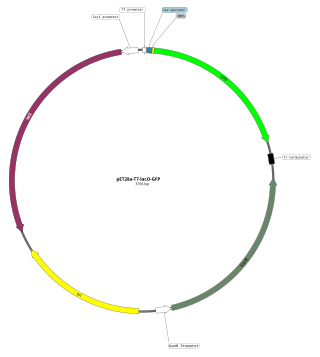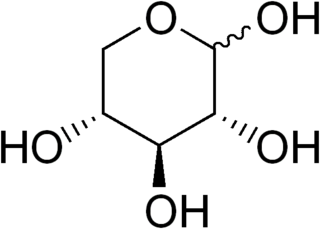
An expression vector, otherwise known as an expression construct, is usually a plasmid or virus designed for gene expression in cells. The vector is used to introduce a specific gene into a target cell, and can commandeer the cell's mechanism for protein synthesis to produce the protein encoded by the gene. Expression vectors are the basic tools in biotechnology for the production of proteins.

Totiviridae is a family of double-stranded RNA viruses. Giardia lamblia, leishmania, trichomonas vaginalis, and fungi serve as natural hosts. The name of the group derives from Latin toti which means undivided or whole. There are 28 species in this family, assigned to 5 genera.

Komagataella is a methylotrophic yeast within the order Saccharomycetales. It was found in the 1960s as Pichia pastoris, with its feature of using methanol as a source of carbon and energy. In 1995, P. pastoris was reassigned into the sole representative of genus Komagataella, becoming Komagataella pastoris. Later studies have further distinguished new species in this genus, resulting in a total of 7 recognized species. It is not uncommon to see the old name still in use in the contect of protein production, as of 2023; in less formal use, the yeast may confusingly be referred to as pichia.

The Saccharomycetaceae are a family of yeasts in the order Saccharomycetales that reproduce by budding. Species in the family have a cosmopolitan distribution, and are present in a wide variety of habitats, especially those with a plentiful supply of carbohydrate sources. The family contains the species Saccharomyces cerevisiae, perhaps the most economically important fungus.

Pichia is a genus of yeasts in the family Pichiaceae with spherical, elliptical, or oblong acuminate cells. Pichia is a teleomorph, and forms hat-shaped, hemispherical, or round ascospores during sexual reproduction. The anamorphs of some Pichia species are Candida species. The asexual reproduction is by multilateral budding.
Cell wall protein 2 (CWP2) is a cell wall protein, produced by Saccharomyces cerevisiae and Saccharomyces pastorianus. It occurs throughout the cell wall and has close homology with the CWP1 gene.

Ogataea polymorpha is a methylotrophic yeast with unusual characteristics. It is used as a protein factory for pharmaceuticals.
A yeast expression platform is a strain of yeast used to produce large amounts of proteins, sugars or other compounds for research or industrial uses. While yeast are often more resource-intensive to maintain than bacteria, certain products can only be produced by eukaryotic cells like yeast, necessitating use of a yeast expression platform. Yeasts differ in productivity and with respect to their capabilities to secrete, process and modify proteins. As such, different types of yeast are better suited for different research and industrial applications.

D-Xylose is a five-carbon aldose that can be catabolized or metabolized into useful products by a variety of organisms.
A killer yeast is a yeast, such as Saccharomyces cerevisiae, which is able to secrete one of a number of toxic proteins which are lethal to susceptible cells. These "killer toxins" are polypeptides that kill sensitive cells of the same or related species, often functioning by creating pores in target cell membranes. These yeast cells are immune to the toxic effects of the protein due to an intrinsic immunity. Killer yeast strains can be a problem in commercial processing because they can kill desirable strains. The killer yeast system was first described in 1963. Study of killer toxins helped to better understand the secretion pathway of yeast, which is similar to those of more complex eukaryotes. It also can be used in treatment of some diseases, mainly those caused by fungi.

Dendroctonus is a genus of bark beetles. It includes several species notorious for destroying trees in the forests of North America. The genus has a symbiotic relationship with many different yeasts, particularly those in the genera Candida and Pichia that aid in digestion and pheromone production.
Scheffersomyces stipitis is a species of yeast, belonging to the "CUG Clade" of ascomycetous yeasts. This is a group of fungi that substitute serine for leucine when the CUG codon is encountered. S. stipitis is distantly related to brewer's yeast, Saccharomyces cerevisiae, which uses the conventional codon system. Found, among other places, in the guts of passalid beetles, S. stipitis is capable of both aerobic and oxygen limited fermentation, and has the highest known natural ability of any yeast to directly ferment xylose, converting it to ethanol, a potentially economically valuable trait. Xylose is a hemicellulosic sugar found in all angiosperm plants. As such xylose constitutes the second most abundant carbohydrate moiety in nature. Xylose can be produced from wood or agricultural residues through auto- or acid hydrolysis. Ethanol production from such lignocellulosic residues does not compete with food production through the consumption of grain.

Herman Jan Phaff was a scientist who specialised in yeast ecology. He was born in the Netherlands before moving to California at age of 26. He was active in Californian universities until his death. During his career he accumulated thousands of strains of yeast from the wild, and described 60 new taxa of yeast.
Pichia heedii is a species of yeast in the family Saccharomycetaceae. Described in 1978, it was found growing on a dead senita cactus plant in the Sonoran Desert of Baja California, Mexico. The species was named to honor William B. Heed and his contributions to the study of desert-adapted yeasts.

The role of yeast in winemaking is the most important element that distinguishes wine from fruit juice. In the absence of oxygen, yeast converts the sugars of the fruit into alcohol and carbon dioxide through the process of fermentation. The more sugars in the grapes, the higher the potential alcohol level of the wine if the yeast are allowed to carry out fermentation to dryness. Sometimes winemakers will stop fermentation early in order to leave some residual sugars and sweetness in the wine such as with dessert wines. This can be achieved by dropping fermentation temperatures to the point where the yeast are inactive, sterile filtering the wine to remove the yeast or fortification with brandy or neutral spirits to kill off the yeast cells. If fermentation is unintentionally stopped, such as when the yeasts become exhausted of available nutrients and the wine has not yet reached dryness, this is considered a stuck fermentation.
Kuraishia is a genus of two species of ascomycetous yeasts in the family Saccharomycetaceae. The type species Kuraishia capsulata was originally described as a member of Hansenula in 1953.
Gcn4 is a transcription factor and a “master regulator” for gene expression which regulates close to one tenth of the yeast genome. In a study by Razaghi et al, amino acid starvation activated the transcription factor Gcn4p, resulting in transcriptional induction of almost all genes involved in amino acid biosynthesis, including HIS4. Thus involvement of Gcn4 in regulation of both histidinol dehydrogenase HIS4 and interferon gamma hIFNγ was hypothesised as a scenario explaining the increased level of hIFNγ under amino acid starvation.
Metschnikowia pulcherrima is a ubiquitous species of yeast, with numerous strains, belonging to the family Metschnikowiaceae, and found on grapes, cherries, flowers, spoiled fruit and consequently carried by fruit flies. It is a non-Saccharomyces yeast and plays an important role in the vinification of wine when it is present on grapes or winery equipment, and has historically seen use in South Africa’s wine industry. It is also being studied at the University of Bath as a possible alternative to the use of Palm oil, and early results show promise. M. pulcherrima is ovoid to ellipsoidal in shape and reproduces by budding. Its cells are globose and thick-walled, holding a single, large oil droplet of high refractive index. As the result of incomplete budding where cells remain attached after division, pseudohyphae may form under anaerobic conditions.
Pundi Narasimhan Rangarajan is an Indian biochemist, virologist and a professor at the department of biochemistry of the Indian Institute of Science. Prof Rangarajan is currently the Chairman of the Department of Biochemistry at Indian Institute of Science. Known for his research on eukaryotic gene expression, Rangarajan is an elected fellow of all the three major Indian science academies viz. National Academy of Sciences, India, Indian Academy of Sciences and Indian National Science Academy. The Council of Scientific and Industrial Research, the apex agency of the Government of India for scientific research, awarded him the Shanti Swarup Bhatnagar Prize for Science and Technology, one of the highest Indian science awards for his contributions to Medical Sciences in 2007.
Kahm or Kahm yeast is a layer of wild yeast which tends to form on fermented foods such as sauerkraut. It is typically harmless but the smell and appearance tends to spoil the food. The yeast genera which form these films include Debaryomyces, Mycoderma and Pichia.









